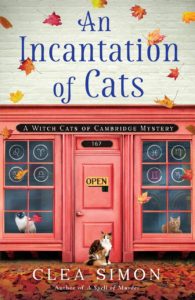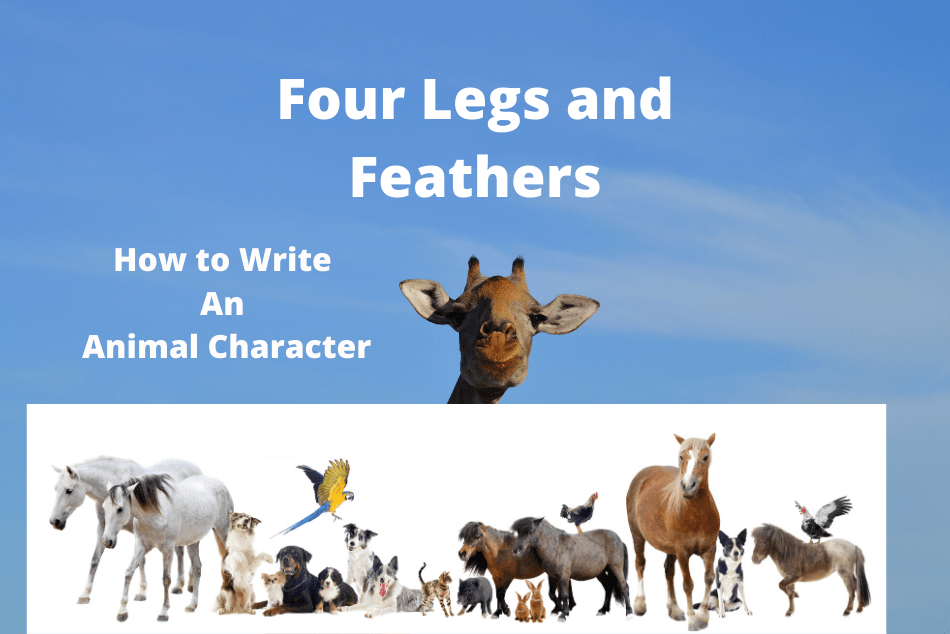I love cooking, but I’m known for my stews and soups rather than my baked goods. Maybe that’s because I’m an improviser by heart. I don’t like following recipes and, as a writer, I’m deeply suspicious of anything that smells like a formula. So I’m not going to try to tell you how to pen a mystery with an animal in it. In truth, although roughly 25 of my books feature some kind of four-legged character (usually a cat), I don’t have a basic outline for how to do it. Each time is starting from scratch. However, as I begin to write a third “Witch Cat of Cambridge” cozy – and celebrate the release of An Incantation of Cats (Polis), the second in the series – I do recognize that I’ve learned a few things about mysteries with animals in them.
Know your beast
Whether you are writing a pet cozy or a full-on animal fantasy (a la Watership Down or The Wind in the Willows), it is vital that you understand the creatures you want to depict. Yes, you are creating a work of fiction, and, no, in the real world, no animal character wears pants or drives a car (Mr. Toad, anyone?). And, yes, of course, you want your book to have a general appeal, reaching beyond simply kitten-smitten animal lovers or the allergic (or lease-constrained) pet deprived. However, a core group of those who read any book with an animal in it will know (and love) that animal. Writing a cat who doesn’t wash or get distracted by a hanging string will be a dead giveaway that you’ve never cohabited with one.
Research your animal as you would your poisons and clues.
Spend time with a neighbor’s pet or visit a shelter. And, please, ask questions about why the animal is acting a certain way – and what it might do if frightened, angry, possessive, or alarmed. You don’t have to be a behaviorist, but get the basic character right, or risk hisses and snarls.
Engage the animal
Animals are more than window dressing. They have to be, to please the animal-loving reader. Sure, having a cat on the cover is going to help your cozy sell. But if Fluffy is barely present in the story, you’re going to lose a potential series fan when s/he reaches page 200 with barely a mention of that furry sprite. I know this is sometimes beyond authors. Too often publishers use the pet trope to signal cozy, without thinking of what this promises to the animal lover. That means authors need to be especially aware of the feeling of betrayal a misleading cover can cause. Either reason with your publisher or write Fluffy into the plot. Surely, your protagonist needs someone to talk over all those clues with.
Any animal can be cute
Yes, cats and dogs are the leading mystery sidekicks (or sleuths on their own), with both rescues and even various breeds launching series. But plenty of mysteries have been set around horses, birds, even anteaters (thank you, Betty Webb and Donna Andrews!). The key is that you, the author, feel affection or at least sympathy for the wee beastie (and see Rule #2, above). Hey, if I could spend time with a ferret and find his agile little hands fascinating, you can too. Has there been a hamster cozy? Why not?
Read your peers
Most of us got it this because we grew up reading Lillian Jackson Braun or we fell for Rita Mae Brown’s Sneaky Pete mysteries. But have you kept up with what Shirley Rouseau Jackson or Susan Conant are doing? Shannon Esposito or Linda O. Johnston? Amy Shojai? Carole Nelson Douglas? Liz Mugavero? Peter Abrahams? Diane Stuckart? Writers are constantly expanding the genre, working out different relationships and roles. If you don’t read it, why are you writing it?
Respect the genre
If I never hear another dismissive comment – “oh, you write cat mysteries” – I will die content. But I know I’ve been guilty of it myself, apologizing in advance for my particular niche, usually with a wincing smile. I wouldn’t accept that from writers of any other subgenre – thrillers, noir, cooking cozies, or whatever. I know that it takes just as much skill and dedication to craft something that seems sweet and frothy as it does dark or heavy. You know that old saw about Ginger Rogers? That she did everything Fred Astaire did, only backwards and in heels? That’s us, folks. Or, to quote W.B. Yeats, “a line will take us hours maybe, but if it seems more than a moment’s thought, our stitching and unstitching is for naught.” Don’t be like me, folks, and I promise to do better myself. Yes, I write cat cozies! Sometimes the kitty is the sleuth. Deal with it!
Don’t limit yourself to cozies
Paula Munier’s psychological suspense feature dogs, and my own Blackie and Care series is dystopian and dark. Sure, most animal mysteries tend toward the cozy. But they don’t have to. Animals have adventures and lives beyond being our pets, and those of us who grew up on the Walter Farley Black Stallion books or Jack London’s White Fang are surely ready for a new, adult alternative. Maybe you’re dreaming of a wolf protagonist who has to kill or be killed. Hmmmm… I’d want to read that. Wouldn’t you?
Never, ever kill or seriously hurt an animal
Silly? Yeah. Sentimental, sure. But this truly is an iron-clad rule. I read across the spectrum – and I love my noir very dark and bitter. But I was enjoying a popular author’s historical mystery when he killed a character’s cat. The move made sense – the villain was implicitly threatening the character. The writing was lovely, and the violence wasn’t graphic. Didn’t matter. I put the book down and have not picked up another by that author. Don’t be that author. Don’t kill the cat.
Do you have animals in your novels? What are your secrets to making them real? And when you read about animals, what mistakes drive you crazy? Let’s talk about our four legged and feathered friends on the Career Authors Facebook Page.

Clea Simon is the author of more than 25 mysteries, many of which involve cats. Her  latest, An Incantation of Cats, comes out this month from Polis Books. She can be reached at http://www.cleasimon.com
latest, An Incantation of Cats, comes out this month from Polis Books. She can be reached at http://www.cleasimon.com





